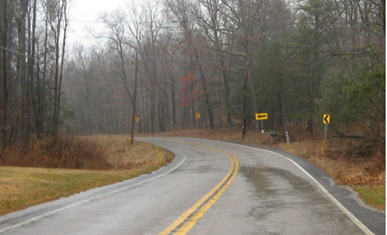Focus on Reducing Rural Roadway Departures (FoRRRwD)
FoRRwD uses a logical approach with innovative tools and techniques to reduce deaths and serious injuries in rural roadway departure crashes. It is a Federal Highway Administration (FHWA) Every Day Counts Round 5 (EDC-5) innovation that Pennsylvania championed.
Pennsylvania sustains more fatalities and serious injuries on average each year due to vehicles departing their travel lane compared to any other crash type. A lane departure occurs when a vehicle crosses the edge line or center line of a roadway. Two-thirds of all fatal and serious injury lane departures include a collision with a fixed object, most commonly trees, utility poles, embankments and guiderail.
How Does It Work?
FoRRRwD is based on four concepts:
1. Consider all rural public roads - About half of all fatal and serious injury lane departures in Pennsylvania occur on rural roads. These crashes can occur across the entire roadway network.
2. Flexible countermeasures that work - Cost-effective countermeasures that are proven to reduce these crashes fall into three categories:
- Help drivers stay in their lane. This is the first line of defense.
- Reduce the potential for crashes if drivers do leave their lane. Countermeasures in this category provide a safe way to come to a stop or get back on the road.
- Minimize the severity of crashes if they happen. The countermeasures are also flexible and may be used individually or in combination.
3. The systemic approach addresses widely dispersed crashes - Rural roadway departure crash locations are random and change from year to year. This makes it challenging to choose the best locations to install the proven countermeasures. Safety analysis tools are used to help identify locations that are at highest risk of future roadway departure crashes. Once agencies know which locations and corridors are at high risk of roadway departures, they can install countermeasures systemically across the network.
Given Pennsylvania’s large rural network, roadway departure crashes must be addressed through systemic and spot- specific infrastructure improvements. Behavioral safety efforts that deal with seat belt use, distracted driving and impairment are equally important to improving this emphasis area.
4. A plan to get people home safely - Documenting the systemic analysis into a simple safety action plan is a powerful way to prioritize safety improvements and justify investment decisions.
The safety plan framework is flexible and can be customized to local needs. Safety plans can range from just a few pages to several chapters and appendices. A formal plan will also help to communicate more clearly with stakeholders as well as access funding opportunities.
PennDOT’s Local Technical Assistance Program (LTAP) has training and other resources available to help local agencies develop safety action plans.

What Are The Benefits?
- Proactive approach. Systemic analysis enables professionals to mitigate high-risk locations, sometimes before crashes even happen.
- Targeted investments. Projects are based on data and risk, so investments can be made with more confidence.
- Flexibility. There is a wide range of analysis and countermeasure selection tools to fit any level of data and expertise.
- Safer roads. The combination of proven countermeasures installed at targeted, high-risk locations is the key to reducing rural roadway departures.
Innovation in Motion
Reducing lane departures crashes is a priority emphasis area in the Pennsylvania Strategic Highway Safety Plan because more than half of all fatalities involve this crash type (refer to graphic below). Systemic improvements on rural roads such as improving roadside clear areas, adding centerline/shoulder rumble strips, and High Friction Surface Treatments (HFST) help to address these crashes.
Additional efforts underway include:
- PennDOT is collecting horizontal and vertical curvature data for all roads to then be able to isolate the curves with the highest crash probabilities. This will lead to a much better systemic safety approach to lane departure crashes.
- PennDOT is identifying rural areas with the longest emergency response times. This would demonstrate a need for increased infrastructure investment in these locations.
- PennDOT will soon complete a project which will enable them to generate crash clusters for locally owned roads. This will allow PennDOT to target lane departure crash cluster sites on locally owned roads with countermeasures like HFST, signs and delineation, rumble strips, advance curve warning pavement markings, select tree removal, utility pole relocation, and more.
- The LTAP program has free courses available to local municipalities that help address rural roadway departure crashes such as Local Road Safety Plans, Curves on Local Roads, and Roadside Safety Features. For information on these and other LTAP courses, visit LTAP’s website.
More Information